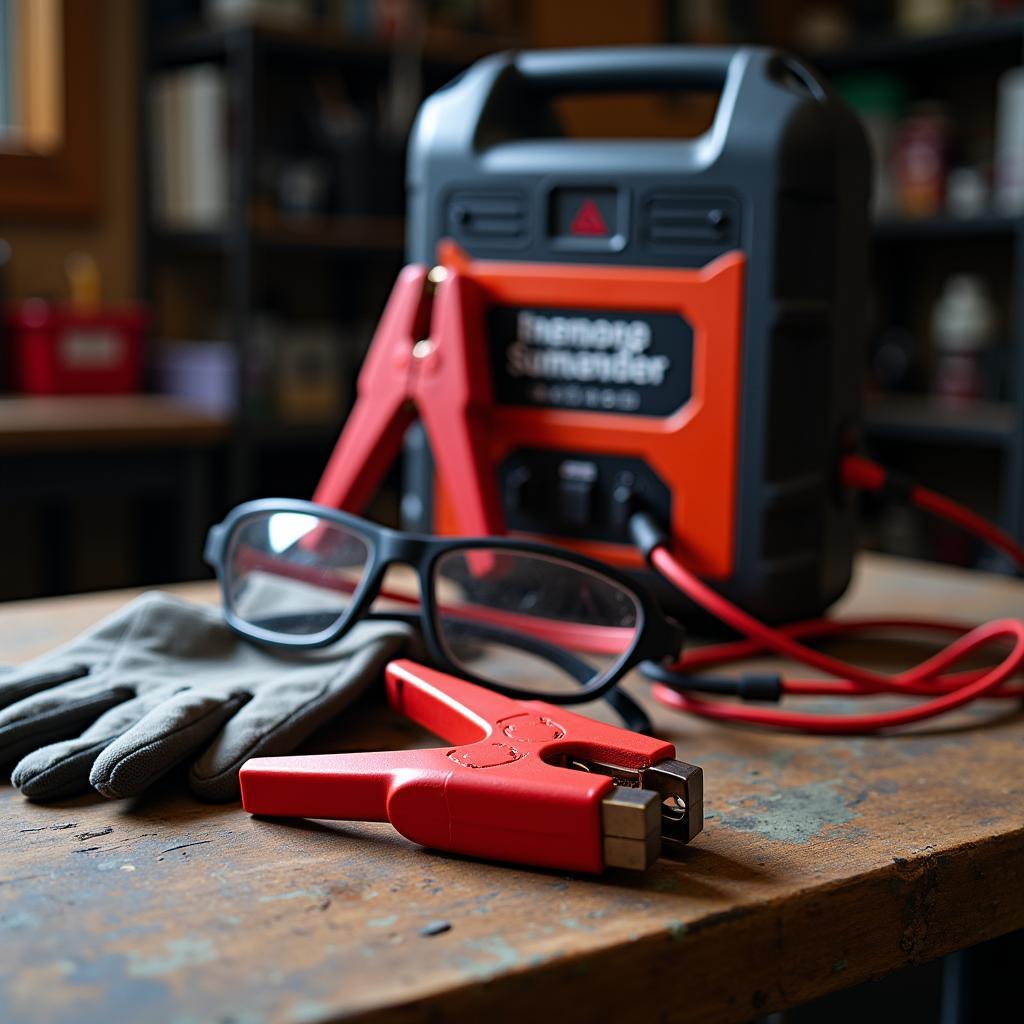Jump-starting a car is a common roadside emergency, and knowing how to do it safely and effectively can save you time, money, and frustration. Having the right tools to jump start a car is critical. This article will guide you through the essential tools you need and explain how to use them properly. We’ll cover everything from traditional jumper cables to portable jump starters and even some helpful accessories you might consider.
Understanding the Basics of Jump Starting
Before diving into the tools, let’s briefly review the principles behind jump-starting. A dead car battery lacks the necessary charge to power the starter motor, which cranks the engine. By connecting a charged battery to the dead one, you provide the needed boost to get the engine running. Once the engine is on, the car’s alternator takes over, recharging the dead battery. car tool kits can often include the essentials for jump-starting.
Why are the Right Tools Important?
Using the correct tools to jump start a car is crucial for safety and efficiency. Improper tools or techniques can damage your car’s electrical system, or worse, cause injury.
Essential Tools to Jump Start a Car
Jumper Cables: The Old Reliable
Jumper cables are the most common tool for jump-starting a car. They consist of two insulated wires, usually red and black, with clamps on each end. Choose a good quality set with thick gauge wires (at least 6 gauge) for optimal current transfer. Longer cables offer more flexibility, which is helpful if you can’t park the cars nose-to-nose.
Portable Jump Starters: The Modern Solution
Portable jump starters are compact, battery-powered devices that can jump-start a car without the need for another vehicle. These devices are incredibly convenient and often include features like USB ports for charging devices, built-in flashlights, and even air compressors. car jumper tools now often include these versatile devices. They are an excellent addition to any car tool kits.
Safety Gear: Protecting Yourself
Safety should always be a priority when working with car batteries. Wear safety glasses and gloves to protect yourself from acid splashes and sparks.
 Safety Gear for Jumpstarting
Safety Gear for Jumpstarting
Optional but Helpful Accessories
- Battery Terminal Cleaner: Corroded battery terminals can hinder the flow of current. A wire brush or terminal cleaner can quickly resolve this issue.
- Multimeter: A multimeter can help diagnose battery problems and ensure the charging system is working correctly.
How To Jump Start a Car with Jumper Cables
- Position the Vehicles: Park the working car close to the stalled car, ensuring the batteries are accessible.
- Connect the Red Clamp: Attach the red clamp to the positive (+) terminal of the dead battery.
- Connect the Other Red Clamp: Attach the other red clamp to the positive (+) terminal of the good battery.
- Connect the Black Clamp: Attach the black clamp to the negative (-) terminal of the good battery.
- Connect the Final Black Clamp: Attach the final black clamp to a clean, unpainted metal surface on the stalled car’s engine block, away from the battery. tools needed to jumpstart a car always include instructions for proper grounding.
- Start the Working Car: Let the working car run for a few minutes to charge the dead battery. matco tools car jump starter are known for their reliability in such situations.
- Start the Stalled Car: Try starting the stalled car.
- Disconnect the Cables: Once the stalled car starts, disconnect the cables in the reverse order of connection.
“Always prioritize safety when jump-starting a car,” advises John Smith, a certified automotive technician with over 20 years of experience. “Using the correct tools and procedures can prevent damage to your vehicle and ensure a successful jump-start.”
Conclusion
Having the right tools to jump start a car can make all the difference in a roadside emergency. Whether you opt for traditional jumper cables, a convenient portable jump starter, or both, ensuring you have the necessary tools and knowledge can save you time and hassle. Remember to always prioritize safety and follow the proper procedures. car repair tools clipart jumper cable can provide visual guidance for cable connections.
FAQ
- How long do jumper cables need to be? Aim for cables at least 10-12 feet long.
- Can I jump-start a car with a completely dead battery? It might be extremely difficult, and a portable jump starter is often a better option in this scenario.
- Why is it important to connect the negative cable to the engine block? This helps prevent sparks near the battery, which could be dangerous.
- What should I do if the car doesn’t start after being jump-started? There could be a more serious issue with the car’s electrical system or engine, and you should seek professional help.
- How often should I replace my jumper cables? Inspect them regularly and replace them if they show signs of wear and tear, such as frayed wires or loose clamps.
Common Jump Starting Scenarios
- Dead Battery After Leaving Lights On: This is a very common scenario, easily remedied with a jump-start.
- Battery Drained in Cold Weather: Cold temperatures can significantly reduce battery performance.
- Old Battery Needing Replacement: An old battery might not hold a charge effectively, requiring frequent jump-starts. Eventually, replacement will be necessary.
Further Assistance
For more articles related to car maintenance and repair, visit our website. We also have a detailed guide on choosing the right portable jump starter for your needs.
If you require immediate assistance, please contact us via WhatsApp: +1(641)206-8880, Email: [email protected] or visit us at 910 Cedar Lane, Chicago, IL 60605, USA. We have a 24/7 customer support team ready to help.
